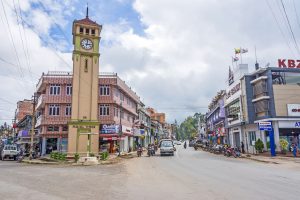Residents of the hill town of Pyin Oo Lwin in Myanmar, including relatives of civil servants and military personnel, are reportedly fleeing south amid rumors of an attack by resistance groups on the town.
The Irrawaddy and other local sources yesterday published photos of cars choking the highway down to Mandalay, Myanmar’s second-largest city, which lies just 64 kilometers to the west. Radio Free Asia (RFA) quoted one resident as saying that “family members of civil servants have been sent to Mandalay and Naypyidaw,” adding, “The locals are worried.”
Pyin Oo Lwin, a scenic hill town in Mandalay Region formerly known as Maymyo, is the home of the Myanmar military’s Defense Forces Academy and is a key garrison town for the armed forces.
Following recent advances in Shan State and Mandalay Region, there are reports that the Ta’ang National Liberation Army (TNLA) and allied People’s Defense Forces (PDFs) will soon begin an offensive on the town. In late June, the TNLA and its allies in the Three Brotherhood Alliance launched the second phase of their Operation 1027 offensive, which has made rapid progress along the axis of the major highway linking Mandalay to the Chinese border.
In northern Shan State, the TNLA’s ally, the Myanmar National Democratic Alliance Army, has succeeded in capturing Lashio, the largest city in northern Shan State, consigning the military junta to perhaps its most significant defeat since the coup of February 2021.
Further south, the TNLA has established its control over Mogok, a ruby-mining center in Mandalay Region around 144 kilometers north of Pyin Oo Lwin, and captured Nawnghkio, a town that lies just 56 kilometers to its northeast. Earlier this week, the TNLA announced that the Mandalay People’s Defense Force had also taken complete control of Kyaukme, another town on the main highway between Mandalay and the Chinese border.
RFA reported that junta troops yesterday erected a checkpoint on the highway to restrict the transport of food and other commodities between Pyin Oo Lwin and areas held by the TNLA to the northeast.
If and when an attack might come on Pyin Oo Lwin remains unclear. Writing in Asia Times, analyst Anthony Davis speculated that the TNLA’s recent gains had come at a high cost in terms of causalities, suggesting its need to replenish and reconsolidate its battered forces.
But he said that the opening of a “third western front driving into the national heartland along the Ayeyarwady Valley,” ultimately focused on the sprawling city of Mandalay, marked a watershed in the country’s conflict. The opening of a front in the country’s dry central heartland, which has been free of conflict for most of Myanmar’s post-independence history, was “critically significant” to the course of the war. This push, spearheaded by the TNLA and ethnic Bamar PDFs, including the well-equipped Mandalay People’s Defense Force, would create “logistical and organizational connectivity” with other resistance groups and PDFs based in Mandalay’s north and west.
With the northern part of Shan State now slipping out of junta control, a successful attack down the highway on Pyin Oo Lwin would signal a definitive step toward the siege of Myanmar’s second city – and potentially the beginning of the end for the junta in upper Myanmar.

































